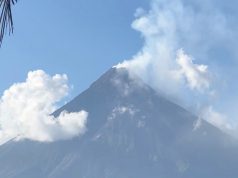
MANILA, Philippines — Albay province’s Mount Mayon, known as the “perfect cone,” has continued to display intense unrest, prompting the government to maintain Alert Level 4 over the restive stratovolcano.
In its 8 a.m. bulletin on January 24, the Philippine Institute of Volcanology and Seismology (Phivolcs) said it had recorded five episodes of “intense but sporadic lava fountaining from the summit crater lasting seven minutes to one hour and twenty minutes” between 8:54 a.m., Tuesday and 3:57 a.m., Wednesday.
When a volcano is placed under Alert Level 4, it means that “hazardous eruption is imminent,” based on Philvocs alert level system.
It also means that the volcano will display persistent tremor, many low frequency-type earthquakes will occur, sulfur dioxide emission level may show sustained increase or abrupt decrease, crater grow will become intense, lava dome will become incandescent, and there will be lava fountain and lava flow in the summit area.
Philvocs said in its latest bulletin that Mayon’s lava fountains had so far reached 500 meters to 600 meters high and generated ash plumes that reached three to five kilometers above the crater.
It said the events had fed lava flows on the Miisi and Bonga Gullies, sprayed near-vent lava spatter, and fed incandescent rockfall on the summit area.
“Pyroclastic density currents or PDCs on gullies heading the Miisi, Lidong/Basud, and Buyuan Channels were also observed. The runout of PDCs on the Buyuan Channel is now exceeding 5 kilometers from the summit crater,” the agency said.
“The public is strongly advised to be vigilant and desist from entering the eight kilometer-radius danger zone, and to be additionally vigilant against pyroclastic density currents, lahars and sediment-laden streamflows along channels draining the edifice,” it added.
Also, Philvocs told civil aviation authorities to advise pilots to avoid flying close to the volcano’s summit as ash from any sudden eruption can be hazardous to aircraft.
Philvocs “maintains close monitoring of Mayon Volcano and any new development will be communicated to all concerned stakeholders.”








